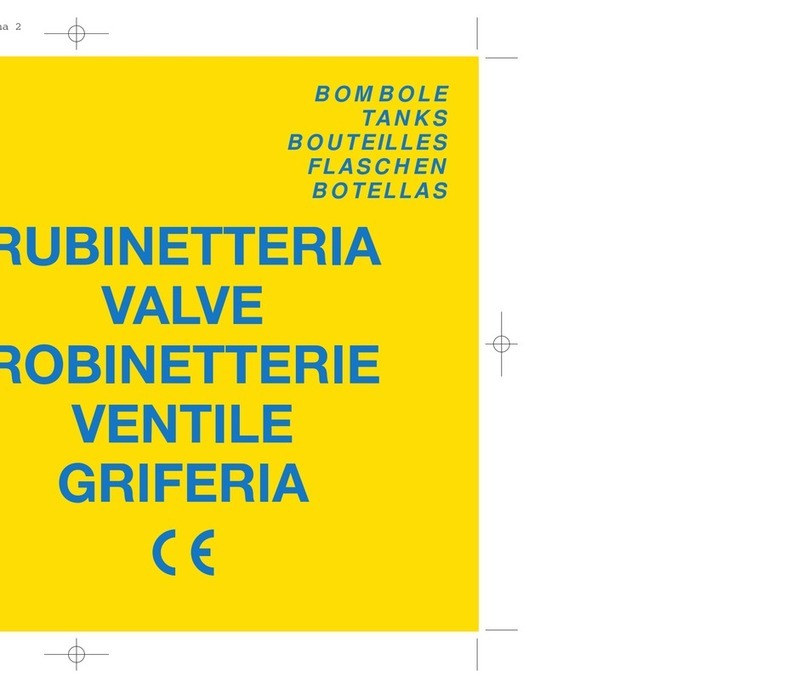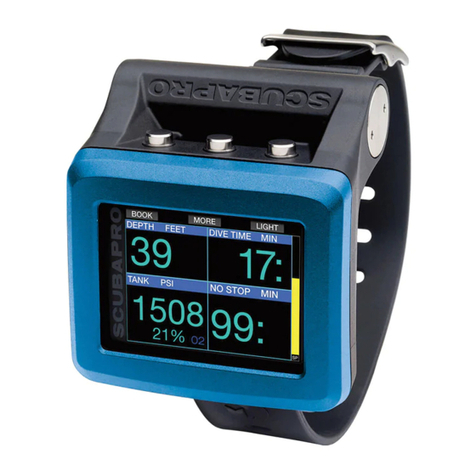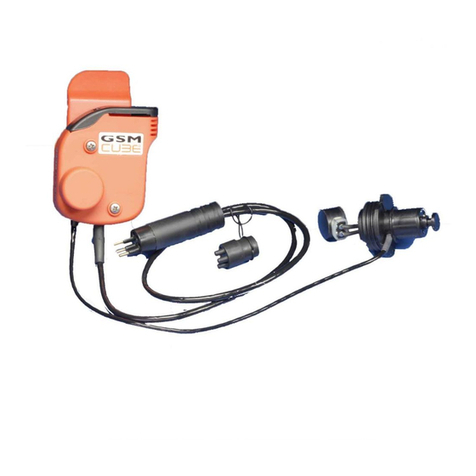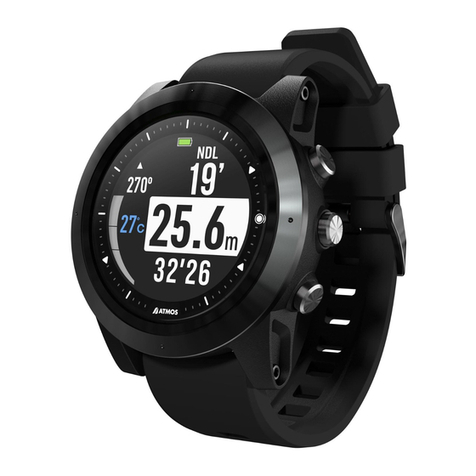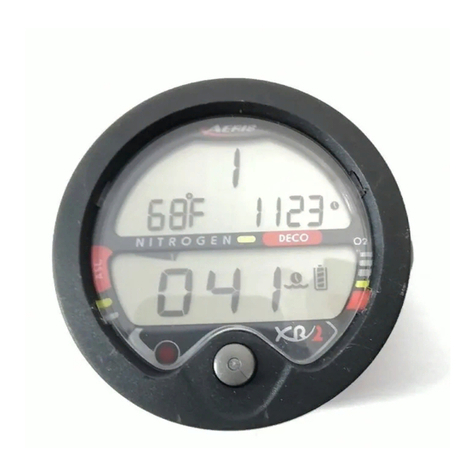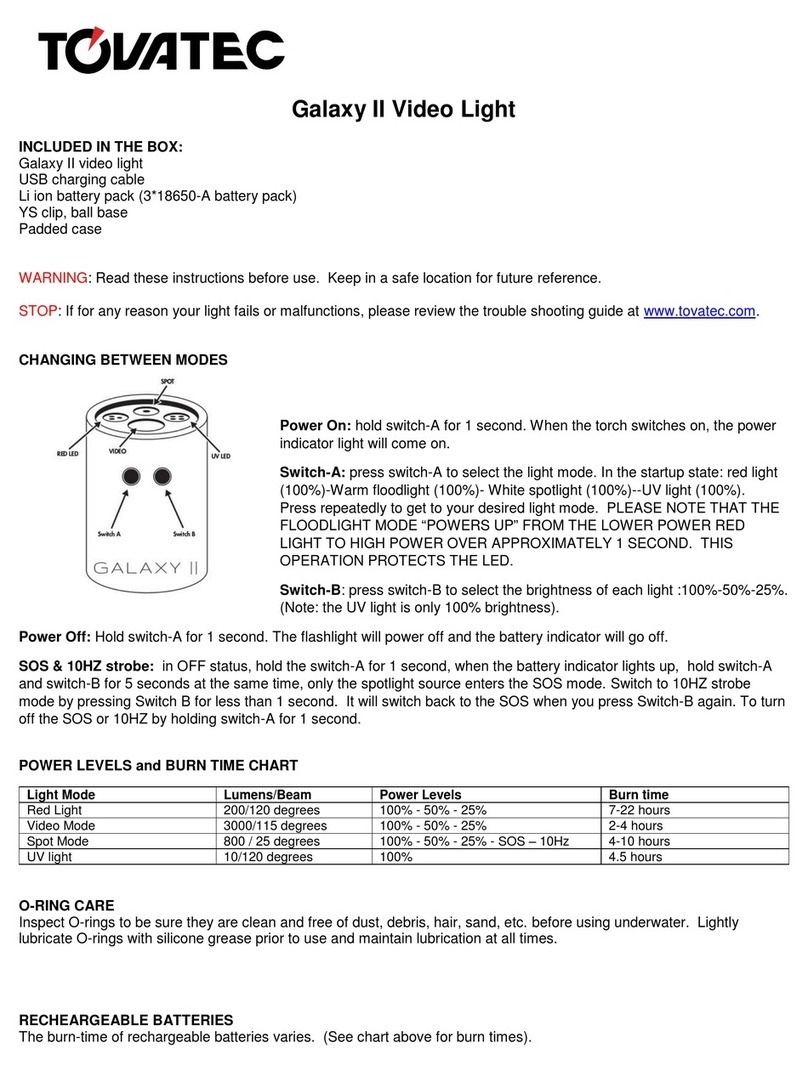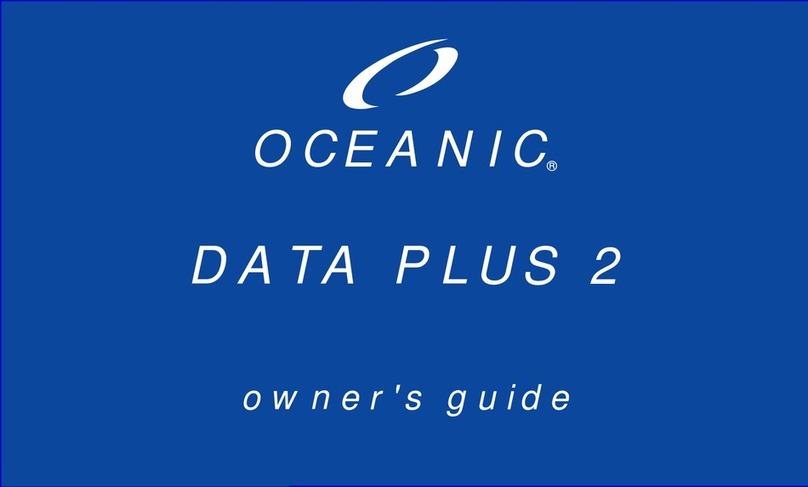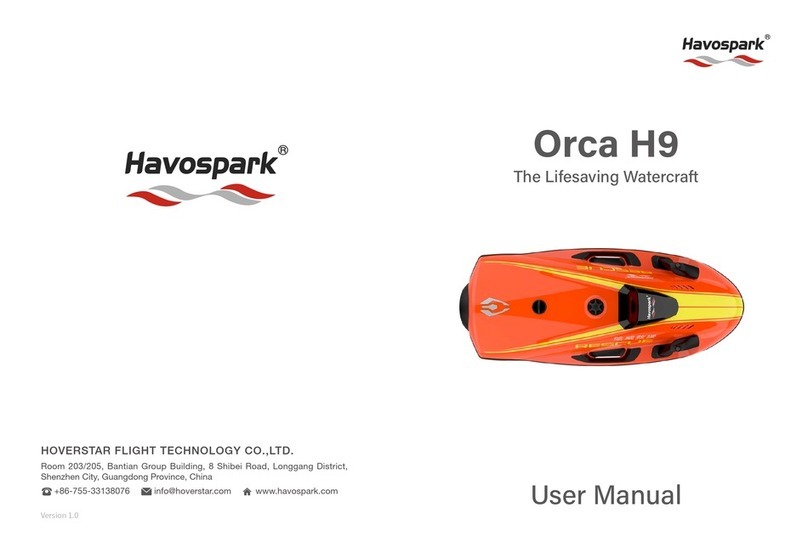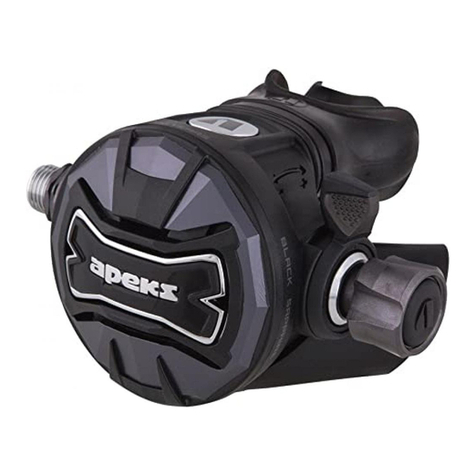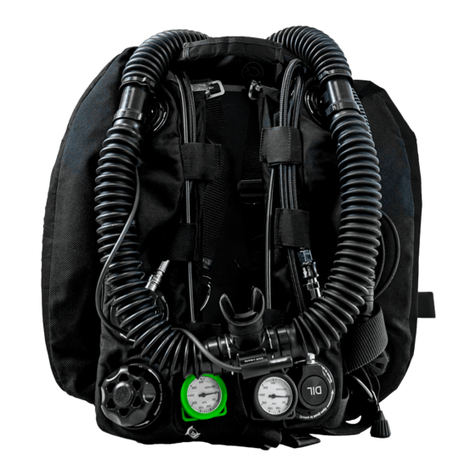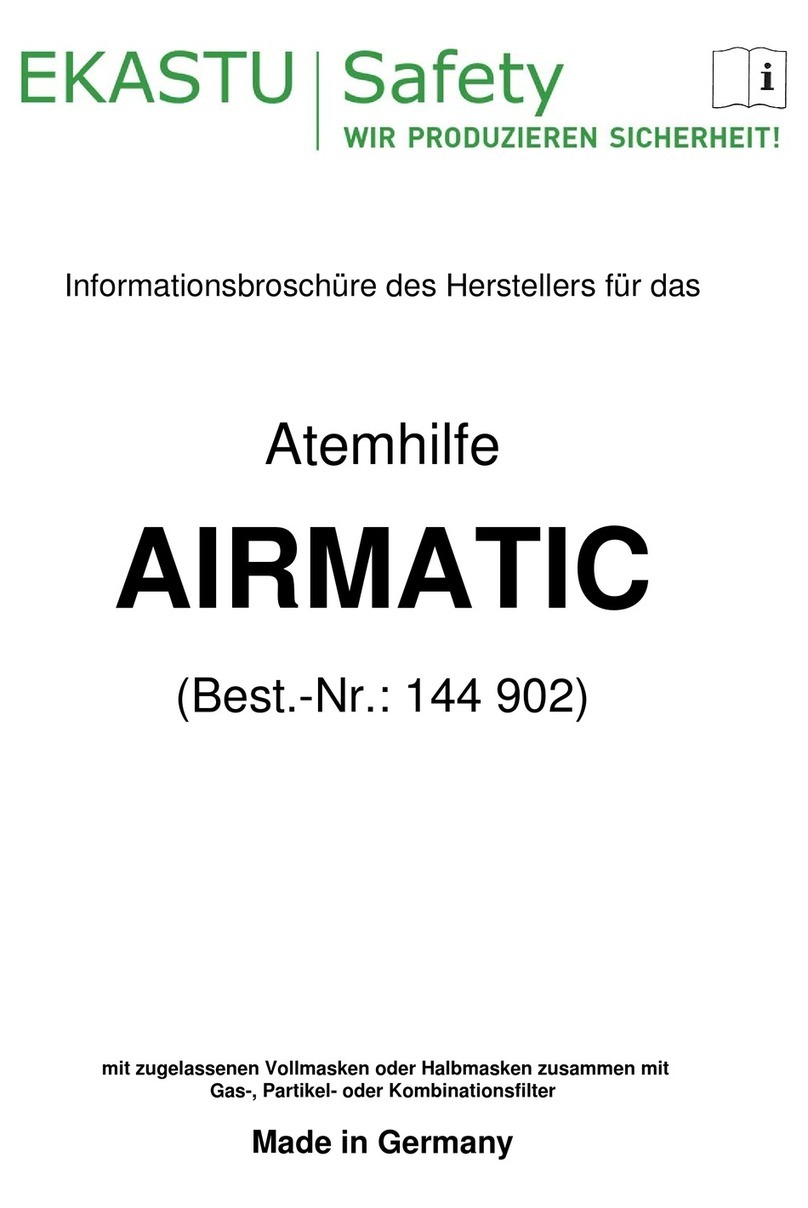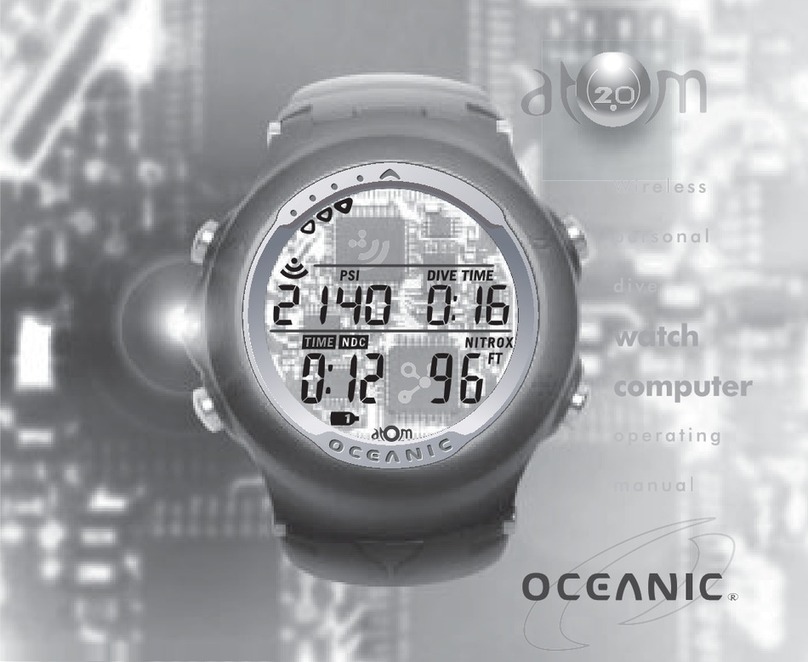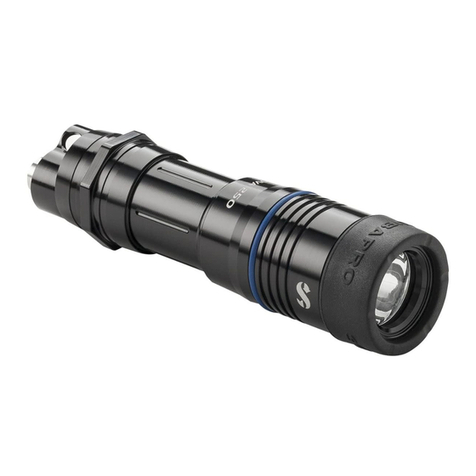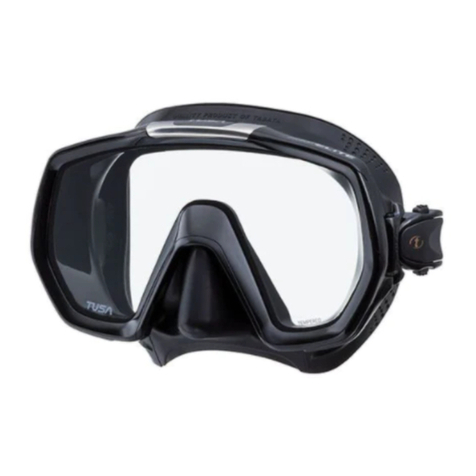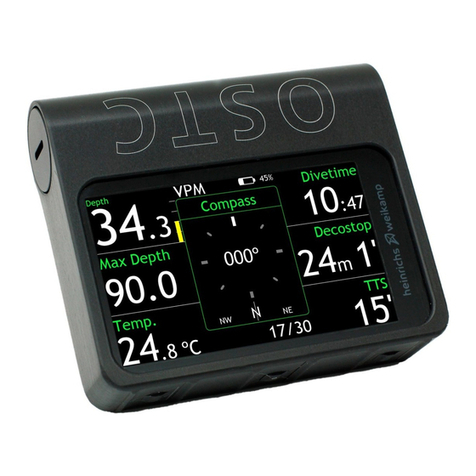Cressi Archimede User manual

Manuale d’istruzioni
Notice d’instructions
Gebrauchsanweisung
Manual de instrucciones
User’s Manual
Cressi Copertina2 28-09-2005 14:25 Pagina 1

User’s Manual
User’s Manual
ENGLISH
ARCHIMEDE 1 27-09-2005 16:17 Pagina 127

TABLE OF CONTENTS
1. - INTRODUCTION . . . . . . . . . . . . . . . . . . . . . . . . . . . . .pag.130
1.1. - Main features . . . . . . . . . . . . . . . . . . . . . . . . . . . . . . .pag.130
1.2. - Safety rules . . . . . . . . . . . . . . . . . . . . . . . . . . . . . . . .pag.130
1.2.1. - Definition of Danger, Important, and Note . . . . . .pag.130
1.2.2. - General Warning and Safety Rules.pag. . . . . . . . .pag.130
1.3. - Introduction . . . . . . . . . . . . . . . . . . . . . . . . . . . . . . . .pag.132
2. - BEFORE DIVE . . . . . . . . . . . . . . . . . . . . . . . . . . . . . . .pag.133
2.1. - UFDS Display and Controls . . . . . . . . . . . . . . . . . . .pag.134
2.2. - On Surface, before Dive . . . . . . . . . . . . . . . . . . . . . .pag.134
2.3. - Parameter Setting . . . . . . . . . . . . . . . . . . . . . . . . . . .pag.135
2.3.1. - Dive Parameter Setting ( ) . . . . . . . . . . . . . . . .pag.135
2.3.2. - Max Depth Alarm . . . . . . . . . . . . . . . . . . . . . . . . . . .pag.136
2.3.3. - Time and Date Adjustment ( ) . . . . . . . . . . . . .pag.136
2.3.4. - Unit of Measure Setting . . . . . . . . . . . . . . . . . . . . . .pag. 137
2.4. - Dive Planning ( ) . . . . . . . . . . . . . . . . . . . . . . .pag. 137
2.5. - Quick Display of Set Data ( ) . . . . . . . . . . . . .pag. 137
3. - DURING DIVE . . . . . . . . . . . . . . . . . . . . . . . . . .pag.138
3.1. - DIVE WITH AIR ( ) . . . . . . . . . . . . . . . . . . . . . . .pag.139
3.1.1. - No Decompression Dive . . . . . . . . . . . . . . . . . . . . .pag.139
3.1.2. - Ascent Rate ( ) . . . . . . . . . . . . . . . . . . . . . . . . .pag.139
3.1.3. - Safety Stop ( ) . . . . . . . . . . . . . . . . . . . . . . . . .pag.140
3.2. - Decompression Warning Alarm ( ) . . . . . . . . .pag.140
3.2.1. - Decompression Dive ( ) . . . . . . . . . . . . . . . . .pag.140
3.2.2. - Violated Decompression Stop Alarm . . . . . . . . . .pag. 141
3.3. - DIVE WITH NITROX ( ) . . . . . . . . . . . . . . . .pag.142
3.3.1. - Before a Nitrox Dive . . . . . . . . . . . . . . . . . . . . . . . . .pag.142
3.4. - Nitrox Parameter Setting: . . . . . . . . . . . . . . . . . . . .pag.142
3.4.1. - Partial Pressure Setting PO2 ( ) . . . . . . . . . . . .pag.142
3.4.2. - Oxygen Fraction Setting FO2 ( ) in Nitrox . . .pag.143
3.5. - CNS Toxicity Display ( ) . . . . . . . . . . . . . . . . . . .pag.144
3.6. - PO2 Alarms ( ) . . . . . . . . . . . . . . . . . . . . . . . . . .pag.145
4. - ON SURFACE AFTER DIVE . . . . . . . . . . . . . . . . .pag.146
4.1. - Data Management . . . . . . . . . . . . . . . . . . . . . . . . . .pag. 147
4.1.1. - Surface Interval Time ( ,,) . . . . . . . .pag. 147
4.1.2. - Dive Logbook ( ) . . . . . . . . . . . . . . . . . . . . . . . .pag. 147
4.1.3. - Dive History ( ) . . . . . . . . . . . . . . . . . . . . . . . . . .pag.149
4.1.4. - Dive profile ( ) . . . . . . . . . . . . . . . . . . . . . . . . . . .pag.149
4.1.5. - Data transfer to PC:
PC-Interface compatible ( ) . . . . . . . . . . . . . . . .pag.150
4.1.6. - Dive Computer Reset . . . . . . . . . . . . . . . . . . . . . . . .pag.150
4.2. - Simulator . . . . . . . . . . . . . . . . . . . . . . . . . . . . . . . . . . .pag. 151
4.2.1. - Dive Simulator ( ) . . . . . . . . . . . . . . . . . . . . . . .pag. 151
4.2.2. - Dive Simulator with Surface
Interval Time ( ) . . . . . . . . . . . . . . . . . . . . . . . . .pag. 151
5. - CARE AND MAINTENANCE . . . . . . . . . . . . . . . . .pag.152
5.1. - Battery Replacement . . . . . . . . . . . . . . . . . . . . . . . . . .pag.152
6. - TECHNICAL FEATURES . . . . . . . . . . . . . . . . . . . . .pag.153
6.1. - No decompression limits
for the first dive in a series . . . . . . . . . . . . . . . . . . . . .pag.154
6.1.1.- Non Decompression tables
for the first dive in a series. . . . . . . . . . . . . . . . . . . . . .pag.154
7. - WARRANTY . . . . . . . . . . . . . . . . . . . . . . . . . . . . . . . . .pag.155
DESAT
SURF.T
Nitrox
129
ENGLISH
ARCHIMEDE 1 27-09-2005 16:17 Pagina 129

1. - INTRODUCTION.
Congratulations on your purchase of an Archimede Cressi-
sub dive computer. It is a sophisticated and comprehensive
device designed to offer you utmost safety, efficiency, and
reliability over time.
1.1. - Main Features.
•Full dive data processor (also applicable
decompression status, if any)
•Battery replacement by the user
•UFDS display for understanding and easy
reading of displayed data;
•Full Nitrox capabilities
•Total Reset Function of Nitrox parameters (FO2 and PO2)
with PO2 setting capability from 1.0 bar to 1.6 bar
•Nitrox dive possibility after dive with air (even with
desaturation under way);
•Manual Planning (Scrolling);
•Unit of measure can be changed by the user
from Metric (m-°C) to Imperial System (ft-°F)
•Audible and visual alarms
•Nitrogen saturation graph
•CNS oxygen toxicity graph
•Enhanced display back light
•Dive simulator (with Surface Interval Time setting
for following dive)
•Built-in calendar clock
•Full dive profile logbook (30hr )
•Dive History
•Total Reset Function.
•PC interface (optional).
1.2. - SAFETY RULES.
1.2.1. - Definition of Danger, Important, and Note.
This manual highlights certain points of particular importance.
Before reading these instructions, it is essential to properly
understand the following definitions:
DANGER: means a situation of serious danger or even
possible death for the diver.
IMPORTANT: means a situation that may become dan-
gerous for the diver or that can damage the equipment.
NOTE: means important information is being provided .
1.2.2. - General Warning and Safety Rules.
IMPORTANT: Read these instructions! Carefully read this
User’s Manual, including the section on safety rules. Be
sure that you have fully understood the use, functions, and
limits of your dive computer before using it!
DANGER: No dive computer can guarantee full protec-
tion against Decompression Sickness (DCS). You need to
understand that there is no procedure in place nor dive
computer that fully eliminates the risk of DCS. No dive com-
puter can determine parameters, such as physiological vari-
ations between individuals, which are also subject to daily
changes. It is advisable to consult a doctor and check your
physical condition before every dive. You should also
remember that several factors may affect susceptibility to
decompression sickness, such as exposure to cold (less
than 50 °F temperature), physical fitness below the norm,
repetitive dives in the same day or in consecutive days, diver
130
ARCHIMEDE 1 27-09-2005 16:17 Pagina 130

fatigue, and dehydration. All these conditions and all those
that can jeopardize your safety should be avoided.
IMPORTANT: this device should be used by certified
divers only. No dive computer can actually replace proper
training. Do remember that dive safety can be ensured by
proper training only.
IMPORTANT: The Archimede Cressi-sub dive computer
has been designed for recreational diving and not for pro-
fessional applications requiring prolonged immersion time
with subsequently increased DCS risk.
IMPORTANT: check your dive computer before use, by
checking battery power and that all LCD segments are
properly displayed. DO NOT dive, if the dive computer
instructions are unclear and, above all, if the low battery
icon is displayed.
IMPORTANT: for your dive, you also need a depth
gauge, a pressure gauge, a timer or a clock, and decom-
pression tables. Always check that the cylinder pressure is
appropriate for the planned dive and, during the dive, use
the pressure gauge to regularly check the amount of air
remaining in your cylinders.
DANGER: Never start your altitude dive, before the
dive computer has automatically set the proper program
for altitude calculation. Check the altitude level on the dis-
play. Remember that in case of dives at more than 9843 ft
above sea level, the risk of DCS is significantly higher.
DANGER: Before any flight travel, wait for the “No Fly
Time” Icon to disappear from the dive computer display.
IMPORTANT: The use of this dive computer is strictly per-
sonal. The information it provides exclusively refers to the
diver who has used it during the single or repetitive dives.
DANGER: Cressi-sub advises you against using this
dive computer for decompression dives. However, should
you exceed the safety curve limits, Archimede Cressi-
Sub dive computer can supply you with all the information
you need for decompression, ascent, as well as proper
surface interval time.
DANGER: Never dive with a Nitrox cylinder without
having personally checked its content and the proper O2
percentage. You should then input this value in the com-
puter. Remember that the dive computer does not accept
FO2 decimal figures. Always round down the figure
(example 35.8% must be rounded down to 35%).
DANGER: for safety reasons, in your Archimede dive
computer, PO2 default value is set at 1.4 bar also for dives
with air. If you need to further raise the safety margin, PO2
can be set at lower values, down to 1.0 bar, with 0.1bar
decreases at a time.
DANGER: : avoid all high risk profile dives, such as the
so called “yo-yo” dives, reversed profile dives, or repetitive
dives in the same day or in consecutive days. They are
potentially risky and involve a high risk of DCS!
IMPORTANT: Turn on the safety factor whenever you
realize that there are factors likely to increase your DCS
risk. You will thus perform a more conservative dive.
NOTE: When flying, it is recommended to keep the dive
computer with you in the pressurized cabin.
ENGLISH
131
ARCHIMEDE 1 27-09-2005 16:17 Pagina 131

Cressi-sub reminds you that sport dives must always be kept
within the safety limits and at maximum 131 ft depth, which is
the standard maximum depth for recreational diving: if you
exceed these limits, you significantly increase your DCS risk.
1.3. - Introduction.
The Archimede Cressi-sub dive computer is a multifunctional
computer for recreational diving, providing you with informa-
tion on depth, dive times, the need for decompression, if any,
as well as on nitrogen absorption and elimination during all
dive phases, including ascent, surface interval times, and
subsequent dives.
All this information is displayed on the large UFDS (acronym
for User Friendly Display System) display, allowing for a simple
and direct ‘dialogue’ between the diver and the computer,
and ensuring a clear understanding of what is being done
and easy reading of displayed information.
The dive computer features a calendar clock, a versatile
memory of past dives, as well as a powerful dive simulator.
A mathematical model is also included, for use with air and
Nitrox. In this latter case, you can set all parameters required
for a Nitrox dive, from FO2 oxygen percentage, to the maxi-
mum allowable PO2 value (from 1.0 bar to 1.6 bar).
The dive computer can also be set by the user by adjusting
the unit of measure with either metric (m -°C) or Imperial sys-
tem (ft -°F).
Also, the Archimede Cressi-sub dive computer can be con-
nected with a compatible personal computer through the
Cressi-sub Interface (optional) and related software (optional).
It is extremely important that you carefully read and under-
stand this User’s Manual. Otherwise,decompression sick-
ness or death may occur. Therefore, the goal is to guide you
to fully understand all the computer functions before you dive
with it.
The time and date function of the Archimede Cressi-sub dive
computer (fig. 1) is always on, with very little battery con-
sumption.
All the various functions are easily turned on with the M
(Mode), A and B buttons. As we will see below, they also turn
on when the contacts get wet during a dive. The dive pro-
gram is turned on at a depth greater than 5ft. All the functions
are clearly illustrated by the figures on the large display.
This User’s Manual has been divided into 5 main topics, for a
better understanding of all dive computer functions and their
meaning:
•1)-Introduction and Safety Rules;
•2)-Before Dive;
•3)-During Dive;
•4)-On surface, after Dive;
•5)-Care and Maintenance.
They deal with all the different dive stages. You will also find
out how easy it is to use and interpret Archimede: each dis-
play screen displays only the data your are interested in,
which refers to that particular situation.
132
ARCHIMEDE 1 27-09-2005 16:17 Pagina 132

2) Before dive
2) Before dive
ENGLISH
Photo Ghisotti
ARCHIMEDE 1 27-09-2005 16:17 Pagina 133

2.1. - UFDS Display and Controls.
The Archimede dive computer is fitted with UFDS (User
Friendly Display System) display ‘accompanying’ the diver dur-
ing every operation. Icons on the display advises you various
operations you are allowed to perform at that particular time.
For example, the icon “light”( ) on the bottom right of the dis-
play, advises you that by pressing the B button, you turn on the
display back light, and so on. In this way, a straightforward ‘dia-
logue’ is in place allowing for an easy understanding of all dive
computer functions.Each icon indicates the function you want
to enter at that particular time.
By repeatedly pressing the M (Mode) button, you can scroll
through all Archimede’s programs, and clearly display them
on the alphanumeric UFDS display. Some of the programs
also have sub-menus that can be accessed with the A and B
(,,)buttons. With these buttons you can also change
surface data settings and with the B ( ) button, you turn on
the display light.
2.2. - On Surface, prior to Dive.
As already mentioned, the dive computer is always ready for
use. It is however important that altitude be correctly set by
the computer. This function is done automatically by the
computer, which updates atmospheric pressure values every
10 minutes and displays the various altitude levels as follows:
no ()icon - from 0 to 2624 ft (fig. 1);
- from 2624 to 5249 ft (fig. 1 - a);
- from 5249 to 7544 ft (fig. 1 - b);
- from 7544 to 19680 ft (fig. 1 - c);
- above 19680 ft—out of range.
Each icon indicates that the computer has automatically
adjusted its mathematical model to the new altitude, thus
providing shorter curve times with increasing altitude.
DANGER: For dives at an altitude of more than 9843 ft
above sea level, DCS risk is significantly higher.
You should remember that if you travel to higher altitudes, the
nitrogen balance between your body and the environment can
be altered. It is advisable that after your arrival to higher altitudes
you wait at least three hours before diving, thus allowing for par-
tial nitrogen elimination from your body. Atmospheric pressure
at higher altitudes is lower than at sea level. When going to high-
er altitudes, the diver will have extra nitrogen in his/her body
i
134
AB
M
ARCHIMEDE 1 27-09-2005 16:17 Pagina 134

ENGLISH
135
than the balanced condition he/she had at the original altitude.
This extra nitrogen is gradually eliminated and the balance
resumed after a couple of days.
At this point you need to carry out a general check to see
that:
• the low battery voltage indicator is not on or blinking (fig. 2);
• the dive computer works and all the LCD segments on the
display are visible.
IMPORTANT: if the battery symbol is displayed (fig. 2),
the computer MUST NOT be used. If you see the same
symbol while diving, you have to stop and ascend to the
surface. The battery must be changed by the user, as indi-
cated in the relevant chapter (Chapter 5.1.) .
2.3. - PARAMETER SETTING.
2.3.1. - Dive Parameter Setting ().
In order to set the parameters of your dive, simply press the
central M (Mode) button repeatedly, until you see the ( )
icon on the UFDS display, as indicated in Figure 3 (max PO2
value setting is blinking). In order to change dive parameters
keep to the following procedure:
By pressing the button A ( ) button, you select, in the fol-
lowing order, dive parameters for:
where :
• PO2 is the maximum partial oxygen pressure. It can be set
by the diver with values from 1.0 bar to 1.6 bar (both values
included), with changes of 0.1 bar, whenever you press the
B ( ). button;
NOTE: When you change the max PO2 value setting (fig.
3), the computer tells you the maximum depth you can
reach with Nitrox (MAX).
IMPORTANT: PO2 default setting by the manufacturer is
1.4 bar for both dives with air and Nitrox. In this way, a safe
dive is ensured in compliance with most recently recom-
mended parameters for recreational dives. However, you
can also change the PO2 as indicated in Chapter 3.4.1.
The new setting will be kept until the next reset by the
diver.
• FO2 is the oxygen percentage present in your Nitrox sup-
ply.
NOTE: by keeping the B ( ) button pressed, the dive
computer will automatically stop on the standard Nitrox 1
(EAN1 32) setting - which corresponds to 32% of O2 in the
Nitrox supply - or on the ( )setting. Obviously, any other
FO2 value from 21% to 50 % can also be set, with 1%
increases at a time.
NOTE: when changing the oxygen percentage in your
Nitrox supply, the dive computer also tells you the maxi-
mum depth that you can reach with that specific supply
(MAX).
• Safety factor (0/1) A safety factor is provided;
i
ARCHIMEDE 1 27-09-2005 16:17 Pagina 135

IMPORTANT: Turn on the safety factor whenever you
realize that there are factors likely to increase your DCS
risk. You will thus perform a more conservative dive.
• Max Depth is the maximum depth alarm (fig. 4 a-b) as we
will see in the next paragraph.
Press the M (Mode) button to go back to the main screen
(fig. 1).
Related topics:
• 2.3.2. - Max Depth Alarm
• 3.1. - DIVE WITH AIR.
• 3.3. - DIVE WITH NITROX.
2.3.2. - Max Depth Alarm.
The Archimede dive computer is fitted with a maximum
depth alarm set by the manufacturer (fig. 4a) and activated
when the diver reaches a depth of 131 ft, which is the limit for
recreational diving. At this point, an audible alarm and a 3 sec-
ond blinking of the display warns you that the set depth has
been reached.
You can always turn it off or change the default value by
keeping to the following procedure:
Keep the A ( ) button pressed and you will highlight the fol-
lowing dive parameters for:
Once you get to the Max Depth (fig. 4 a) screen, press the
A ( ) button and select either the ON or OFF function with
the B ( ) button. If you select ON, you can set the maxi-
mum depth in advance from 0 ft to 325ft, using the A and
B ( and ) buttons.
Press the M (Mode) button to go back to the main screen
(fig. 1).Related topics:
Related topics:
• 2.3.1. - Dive Parameter Setting.
2.3.3. - Time and Date Adjustment ().
In order to adjust the time and date you have to press the M
(Mode) button repeatedly until you see the ( ) icon on the
UFDS display. At this point the display of seconds is blinking
(fig. 5).
Keep the A ( ) button pressed in order to adjust (fig. 5):
1)seconds;2) minutes,3) hours, 4) 12/24h; and (fig. 6): 5)
year;6) month;7) day. Press the A ( ) button, until the func-
tion you want to change begins to blink on the display and
change it by pressing the B ( ) button.
Press the M (Mode) button to go back to the main screen
(fig. 1).
NOTE: always check the right setting of the time and
date, in order to have proper records in the computer log-
book.
Related topics:
• 4.1.2. - Dive Logbook.
i
i
i
i
i
136
ARCHIMEDE 1 27-09-2005 16:17 Pagina 136

2.3.4. - Unit of Measure Setting.
The Archimede Cressi-sub dive computer can calculate and
give you the values in metric units (depth values expressed in
meters and temperature expressed in °C), or in Imperial units
(depth in feet and temperature in °F).
If you want to change the unit of measure, press the M
(Mode) button to access the ( ) screen (fig. 3).Then press
the A+B buttons simultaneously and keep them pressed for
about 15 seconds. At this point the new unit of measure that
you have just set will be displayed.
Press the M (Mode) button to go back to the main screen
(fig. 1).
2.4. - Dive Planning ().
On surface, you can enter the ( ) function, to get a
quick idea of the diving time allowed at the various depths,
using the set Nitrox supply and without having to stop for
decompression. In the case of repeated dives, residual
nitrogen levels are considered, therefore lower time values
are set. By pressing the M (Mode) button twice, you enter
the ( ) function, as indicated on the alphanumeric dis-
play. The screen will show (fig. 7, air; fig.7.1., Nitrox, both with
desaturation under way) the safety curve (no decompres-
sion) limits displayed for the various depths, starting from
30ft, with manual depth increases of 10ft each, every time
you press the B. ( )button, or with manual depth decreas-
es of 10ft each, every time you press the A ( ) button.
Press the M (Mode) button to go back to the main screen
(fig. 1).
Related topics:
•3.1.1. - No Decompression Dive.
•4.1.1. - Surface Interval Time.
2.5. - Quick Display of set data ( ).
With the INFO ( ) icon on the UFDS display of Archimede
Cressi-sub dive computer, when on the surface, you can dis-
play all set parameters for your dive in a quick and easy way
(fig. 8). By pressing the A ( ) button, your dive computer will
display the maximum PO2 value and the corresponding max-
imum depth (expressed either in m or ft); the safety factor, if
any has been set, (SF0/1); the Nitrox percentage and the
corresponding ( ) icon or the ( ) icon if you are going
to take a dive with air.
Related topics:
•3.1. - DIVE WITH AIR
•3.3. - DIVE WITH NITROX.
Nitrox
ENGLISH
137
ARCHIMEDE 1 27-09-2005 16:17 Pagina 137

3) During dive
3) During dive
Photo Olmi
ARCHIMEDE 1 27-09-2005 16:17 Pagina 138

3.1. - DIVE WITH AIR.
The “Dive” program is automatically turned on by the Archimede
dive computer at a depth of more than 5ft. During a no-decom-
pression dive, the following information is displayed (fig. 9):
1present depth, in meters (m) or in feet (ft);
2elapsed dive time, indicated with “DIVE T”
3maximum depth expressed in meters (m) or in feet (ft)
represented by the “MAX” icon;
4no-decompression time still available, indicated by “NDL”
(No Decompression Limit);
5ascent rate indicator in segments;
6bar graph showing the amount of nitrogen absorbed
during the dive;
7pixel graph display showing CNS O2 Toxicity
(see chapter. 3.5.);
8Automatic altitude indicator;
9Nitrox dive indicator, if available;
10 ()and ( ) icons, or “Info” (button A) and display light (but-
ton B).During the dive, if you keep the A ( ) button pressed,
you can also get the following important information (fig. 10 ):
1 present PO2;
2safety factor, if any has been set;
3current temperature, expressed in °C or °F;
4the ( ) icon if you are taking a dive with air (or the FO2%
percentage in your Nitrox) .
The UFDS display shows ( ).
Related topics:
• 2.3. - Parameter Setting.
•3.1.2. - Ascent Rate.
• 3.5. - CNS Toxicity Display.
• 3.6. - PO2 Alarms.
3.1.1. - No Decompression Dive.
3.1.2. - Ascent Rate.
The algorithm used in the Archimede Cressi-sub dive com-
puter uses different ascent rates depending on the depth.
The ascent rate is shown on the display by a segmented indi-
cator located on the display bottom right (fig. 9). The indica-
tor works according to the following table:
If, during the ascent, you exceed the maximum allowed
speed, you will see three full segments on the display, you
will hear an audible alarm and, at the same time, the blinking
()icon will be displayed (fig. 11), and the segment indi-
cator with the ascent rate will also be blinking.
Under these conditions, you must stop your ascent until the
word ( ) disappears and the display is back to normal
status.
ENGLISH
139
Depth
0ft
19.3ft
19,7ft
58.7ft
59ft
5ft
No segment
0.0 ft -
12.8 f/min
0.0 ft -
19.3 ft/min
0.0 m -
25.9 ft/min
1 segment
13.1 ft/min -
19.3 ft/min
19.7 ft/min -
25.9 ft/min
26.2 ft/min -
36 ft/min
2 segments
19.7 ft/min -
25.9 ft/min
26.2 ft/min -
39 ft/min
39.4 ft/min -
52.1 ft/min
3 segments
26.2 ft/min
()
39.4 ft/min
()
52.4 ft/min
()
ARCHIMEDE 1 27-09-2005 16:17 Pagina 139

DANGER: when you ascend too fast, the risk of acci-
dent increases! Cressi-sub recommends to have a 3-5
min. safety stop at 10ft-20ft, at the end of every dive, which
will be assisted by your dive computer (see chapter 3.1.3.)
IMPORTANT: Never dive after a surface interval time
during which the ( ) word was displayed! Computation
for the following dive may be invalidated by excessive
ascent rate during the previous dive.
Related topics:
•3.1.3. - Safety Stop.
•4.1.2. - Dive Logbook.
3.1.3. - Safety Stop ().
Archimede is programmed to automatically warn the diver
about the need for a safety stop, whenever diving below 30ft,
as also recommended by the most recent studies on diving
physiology. This stop shall be made at a depth from 20 to 10ft,
for the time indicated by the dive computer.
NOTA: Cressi-sub recommends to have a 3-5 min. safe-
ty stop at 10-20 ft at every dive.
The safety stop is indicated on the UFDS display with the
()icon (fig. 12). The display here clearly indicates the time
required for the stop in minutes and the depth expressed
either in m or in ft.
Although not compulsory, safety stops are strongly recom-
mended, especially when the maximum ascent rate has
been repeatedly violated. At this point, Archimede requires a
particularly long safety stop, which Cressi-sub advises you to
fully comply with, in order to avoid safety risks.
Related topics:
•2.3.4.- Unit of Measure Setting.
•3.1.2. - Ascent Rate.
3.2. - Decompression Warning Alarm.
Whenever the no decompression limit indicated on the dis-
play by the NDL icon reaches 3 minutes (fig. 13), Archimede
will warn you with an audible alarm while the display will be
blinking for 6 seconds (three of which with flashing light). This
is to warn you that you have exceeded the safety curve and
that you are entering a decompression dive.
Related topics:
•3.2.1. - Decompression Dive.
3.2.1. - Decompression Dive ().
DANGER: Never use this dive computer for dives out-
side the safety limit! Cressi-sub advises you not to use this
dive computer for decompression dives.
Should you exceed the safety limits during your dive, your
Archimede Cressi-sub dive computer can give you all
decompression information required for a correct ascent and
related decompression stops. If you exceed the safety curve,
an audible alarm will be released for 3 seconds, and the
screen on the display will change to look as indicated in
Figure 14. The following information will be provided to the
diver:
1The ( ) icon on the UFDS display will be replacing the
“NDL” one, which advises that you have exceeded the
safety limits and you now have to stop for decompression;
140
ARCHIMEDE 1 27-09-2005 16:17 Pagina 140

2Depth of the first decompression stop, indicated in
meters (m) or in feet (ft); it may range from 100ft to a min-
imum of 10ft, with decreases of 10ft at a time;
3Duration of first decompression stop (the one deepest
down) in minutes;
4“TOTAL” icon indicating total ascent time, namely the
time necessary to ascend up to the first decompression
stop in compliance with the ascent rate (calculated at
26.2ft/min), PLUS the time you need to stop at that
depth, and at the other subsequent depths, if any, PLUS
the time necessary to reach the surface after desatura-
tion completion;
5“DIVE. T” icon, indicating total dive time.
6Bar graph showing the amount of nitrogen absorbed dur-
ing the dive. In this case it will be fully illuminated until the
next “DECO” icon.
DANGER: Never ascend beyond the decompression
stop depth.
In order to avoid this situation, during decompression, always
stay at a depth slightly below the recommended decom-
pression stop depth.
Please remember that under these conditions, the amount of
air you need to complete your dive increases.
In rough sea conditions, it may be difficult to keep to the rec-
ommended decompression stop without violating it. Cressi-
sub therefore recommends to take your last stop - the one
closest to the sea surface - at approximately 12 - 15ft, even if
this will imply a slightly longer decompression stop. In any
case, stop time will be automatically adjusted by your
Archimede dive computer.
Related topics:
• 2.3.4.- Unit of Measure Setting.
• 3.1. - DIVE WITH AIR.
• 3.3. - DIVE WITH NITROX.
• 3.1.2. - Ascent Rate.
• 3.5. - CNS Toxicity Display.
• 3.6. - PO2 Alarms.
• 4.1.2. - Dive Logbook.
3.2.2. - Violated Decompression Stop Alarm.
If a the decompression stop is “violated”, and you have
ascended to a depth that exceeds the decompression stop
indicated in the dive computer, an audible alarm will be
released and at the same time the display will start to blink
until you go back to the ceiling depth or even below (fig. 15).
You have 3 minutes to correct this dangerous situation. After
this time, Archimede will automatically enter the “Error” pro-
gram and the icon ( ) (fig. 16) will be displayed. You will not be
able to use the dive computer for the next 48 hours.
(at least not as a dive computer, but only as a depth gauge or
dive-timer).
DANGER: under these conditions, you cannot dive
again during the following 48 hours.
Carefully monitor yourself for the onset of any DCC related
symptoms, by contacting DAN and a hyperbaric center and
giving them as much information as possible about your dive.
ENGLISH
141
ARCHIMEDE 1 27-09-2005 16:17 Pagina 141

Related topics:
•3.1. - DIVE WITH AIR.
•3.3. - DIVE WITH NITROX.
•3.2.1. - Decompression Dive.
•3.5. - CNS Toxicity Display.
•3.6. - PO2 Alarms.
•4.1.2. - Dive Logbook.
3.3. - DIVE WITH NITROX .
3.3.1. - Prior to a Nitrox Dive.
DANGER: this dive computer can be used for Nitrox
dives only by divers who have completed a full training
course on Nitrox diving.
The Archimede Cressi-sub dive computer can be used for
dives with air, as indicated on the UFDS display with the word
()(fig. 3), as well as for dives with Nitrox (EAN=Enriched Air
Nitrox). In this second case, the icon ( ) will be dis-
played (fig. 10), which will remain visible throughout your dive
and until the parameters for Nitrox dive are set.
IMPORTANT: the computer, when used for AIR dives
()will keep this setting until it is reset by the diver for use
in dives with Nitrox (chapter 2.3.1. - Dive Parameter Setting)
DANGER: Do not make any dive with a Nitrox cylinder
without having personally checked its oxygen content !!
IMPORTANT: Before every dive, always check the oxy-
gen percentage set in your dive computer. You can do so
while still on the surface by pressing the A ( ) button, in
order to get a quick look at the previously set parameters.
Related topics:
•2.3.1. - Dive Parameter Setting
•2.5. - Quick Display of Set Data.
•3.4. - Nitrox Parameter Setting.
•3.5. - CNS Toxicity Display.
•3.6. - PO2 Alarms.
3.4. - Nitrox Parameter Setting.
3.4.1. - Partial Pressure Setting (PO2).
Archimede comes with a default PO2 value of 1.4 bar, for
both dives with Nitrox and with air. This ensures max safety
for every type of dive.
However, you can change the PO2 setting to values ranging
from 1.0 bar to 1.6 bar. If you need to raise the safety margin
of your dive, you can set PO2 at lower values up to a mini-
mum of 1.0 bar. In paragraph 2.3.1 we have already seen how
you can select the various values. Simply press the central
M(Mode) button until the ( ) screen is displayed as illus-
trated in figure 3 and you can then change the parameters
according to the following procedure:
by pressing the A ( ) button, you select the dive parameters
in the following order for::
i
Nitrox
142
ARCHIMEDE 1 27-09-2005 16:17 Pagina 142

where PO2 stands for maximum partial Oxygen pressure
which, as we have already seen, can be set by the diver to
values ranging from 1.0 bar to 1.6 bar, with 0.1 bar increas-
es/decreases at a time by pressing the B ( ) button.
By pressing the A ( ) button, you confirm the selected setting.
Press the M (Mode) to go back to the main screen (fig. 1).
IMPORTANT: the PO2 setting is kept until it is manually
reset by the diver on other values.
Related topics:
•2.3.1. - Dive Parameter Setting.
•3.5. - CNS Toxicity Display.
•3.6. - PO2 Alarms.
3.4.2. - Oxygen Fraction Setting (FO2) in Nitrox.
IMPORTANT: Before every dive, always check the FO2
setting in your dive computer!
In order to set the exact Oxygen fraction contained in your
Nitrox, press the M (Mode) button until the ( ) screen is
displayed, as indicated in figure 3. At this point, parameters
can be changed according to the following procedure:
by pressing the A ( ) button, you select the dive parame-
ters in the following order for:
where FO2 is the oxygen percentage of our Nitrox supply.
NOTE: by keeping the B ( ) button pressed, the dive
computer will automatically stop on the standard Nitrox 1
percentage (EAN32), or on the ( ) setting.
NOTE: when the oxygen percentage is changed, the dive
computer also tells you the maximum depth you can
reach with your Nitrox supply (MAX).
Press the B ( ) button, to manually set other oxygen frac-
tions different from the standard one. With Archimede you can
set O2 fractions ranging from 21% ( ) to 50 %, with
increases of 1% at a time.
Finally, press the A ( ) button to confirm the oxygen fraction
you want to set which will be displayed on the screen.
Press the M (Mode) button to go back to the main screen (fig.1).
NOTE: you can also change the Nitrox setting even dur-
ing surface interval time (with desaturation under way).
This is a very important feature, specially for those who take
repeated dives in a day (e.g. instructors). You can change
your Nitrox supply, after a first dive with air, without having to
wait for desaturation to be completed.
It is important that you follow and understand the following:
1 the Oxygen fraction setting is stored for the first 10 min-
utes of surface interval time from the end of the dive. Any
other dive within this interval will be interpreted by the
computer as a continuation of the previous dive, thus
assumed to be using the same cylinder and hence the
same Nitrox supply.
NOTE: FO2 CANNOT be changed within the first 10
minutes of surface interval from the end of the dive.
i
i
i
ENGLISH
143
ARCHIMEDE 1 27-09-2005 16:17 Pagina 143

Within the first 10 minutes of surface interval, you cannot
enter the ( ) screen to change the parameter settings,
hence you cannot change the previously set oxygen fraction
2 After a 10 minute surface interval, the computer resets
the FO2 fraction at a safety value of 99%, until the diver
resets the correct fraction value for the new Nitrox supply.
“--” will be displayed as in (fig. 17). Obviously, the new
Nitrox supply will have to be checked by the diver before
setting the proper Oxygen fraction in the dive computer.
This situation is indicated on the UFDS display by the ( )
icon, which blinks on the main screen in order to draw your
attention to the need to reset the parameters before diving.
This is a very simple procedure, as previously explained in
Chapter 2.3.
If you happen to forget to reset the new FO2 value, owing to
the automatic reset at 99%, when reaching a depth of just
12ft (with 1.4 P02), the PO2 alarm will warn you accordingly
(fig. 18). The diver could then return to the surface and reset
the correct value. Conversely, if he/she decides to continue
the dive, a second PO2 alarm will be released at 1.6 bar (e.g.
at 19.7ft).
3 Should you set the FO2 value and then take no dive com-
puter will store this value until midnight of the same day,
and will then reset the default value (F02=99%).
Related topics:
•2.3.1. - Dive Parameter Setting.
•3.5. - CNS Toxicity Display.
•3.6. - PO2 Alarms.
•4.1.1. - Surface Interval Time.
3.5. - CNS Toxicity Display
The Archimede Cressi Sub dive computer gives you a graph-
ic display of the degree of Central Nervous System oxygen
poisoning, which is linked to Partial Oxygen Pressure as well
as to the diver’s exposure time to high Partial Oxygen
Pressure (PO2). Figure 19 shows the column formed by 8 pix-
els on the UFDS display indicating the accumulated oxygen
amount. When all eight pixels are illuminated on the display, it
means that the maximum admissible CNS tolerance has
been reached and that you are in serious danger of oxygen
poisoning (hyperoxia).
It is important that constant monitoring of this information is
extremely important. Being a function of Partial Oxygen
Pressure and of exposure time, it requires constantly moni-
tored when diving.
In order to lower the risk of hyperoxia, Archimede considers
all relevant data keeping into account the time and intensity
of exposure to oxygen. When the oxygen level reaches
threshold values, close to maximum admissible toxicity (e.g.
when 7 out of 8 pixels are illuminated), the graph bar begins
to blink and an audible alarm will be released for 15 seconds,
thus warning the diver about the high risk of CNS intoxication
(70% alarm).
When also the 8th pixel is turned on, a second (100%) audible
alarm will be triggered and the graph bar will start to blink until
you start your ascent in order to reduce Partial Oxygen
Pressure. The graph bar will stop blinking only when the 8th pixel
turns off. The alarm will in any case be recorded in the Logbook.
NOTA: Exposure calculation result is rounded to the high-
er percentage value.
Nitrox
144
ARCHIMEDE 1 27-09-2005 16:17 Pagina 144

Related topics:
•3.1. - DIVE WITH AIR.
•3.3. - DIVE WITH NITROX.
•3.4.1. - Partial Pressure Setting (PO2) page.
•3.4.2.- Oxygen Fraction Setting FO2.
•3.6. - PO2 Alarms.
•4.1.2. - Dive Logbook.
3.6. - PO2 Alarm.
The Archimede Cressi-sub dive computer is capable of mon-
itoring another fundamental Oxygen parameter: e.g. O2
Partial Oxygen Pressure (PO2).). As we have already seen,
this parameter can easily be set by the diver (Chapter3.4.1.)
with values ranging between 1.0 and 1.6 bar. The maximum
admissible Partial Oxygen Pressure is assumed to be 1.6 bar.
Depending on the type of Nytrox supply employed, it will
automatically tell you what is the maximum depth reachable.
You should never forget that even when diving with air, you
can get intoxicated with oxygen. This limit changes depend-
ing on PO2 setting. Archimede’s default value is 1.4 bar, cor-
responding to a max depth with air of 183.6ft. Obviously,
other PO2 values can be set, up to a maximum of 1.6 bar.
Therefore, there are two types of PO2 alarms with your
Archimede dive computer:
1 As soon as you reach the maximum depth limit corre-
sponding to the set PO2 value ( from 1.0 bar to 1.6 bar), an
audible alarm will be sent off for 15 seconds and the
( ) icon (fig. 20) will start to blink, while the reached limit
for the PO2 setting will be blinking on the top left of the
display.
2 A second alarm will sound in any case whenever a depth
corresponding to a PO2 value of 1.6 bar is reached. The
display will blink for 15 seconds until you ascend above
the depth limit again.
Both alarms will be recorded in the Logbook.
Related topics:
• 3.1. - DIVE WITH AIR.
•3.3. - DIVE WITH NITROX.
•3.4.1. - Partial Pressure Setting PO2.
•4.1.2. - Dive Logbook.
ENGLISH
145
ARCHIMEDE 1 27-09-2005 16:17 Pagina 145

4) On surface after dive
4) On surface after dive
Photo Ghisotti
ARCHIMEDE 1 27-09-2005 16:17 Pagina 146
Table of contents
Other Cressi Diving Instrument manuals
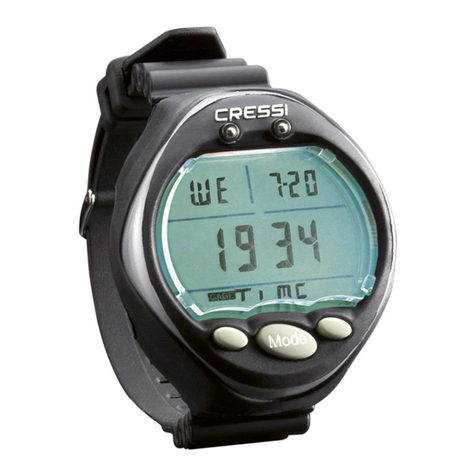
Cressi
Cressi Archimede II User manual
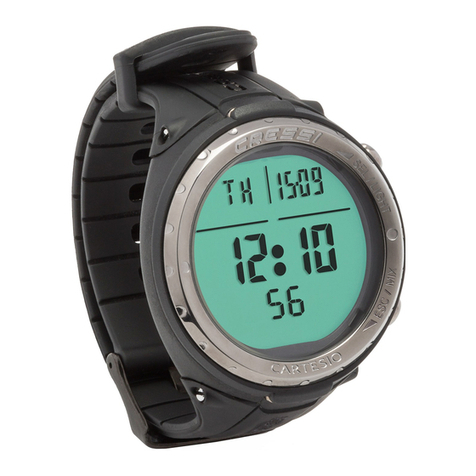
Cressi
Cressi CARTESIO User manual

Cressi
Cressi CARTESIO GOA User manual
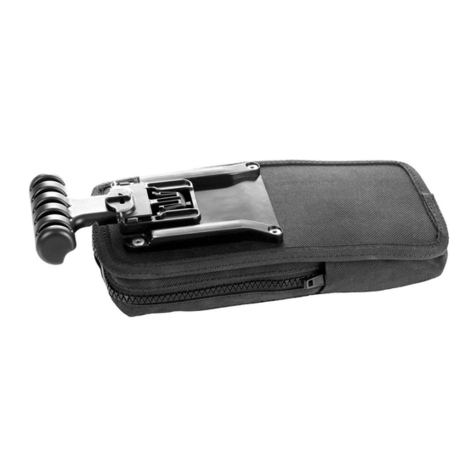
Cressi
Cressi IZ750094 User manual
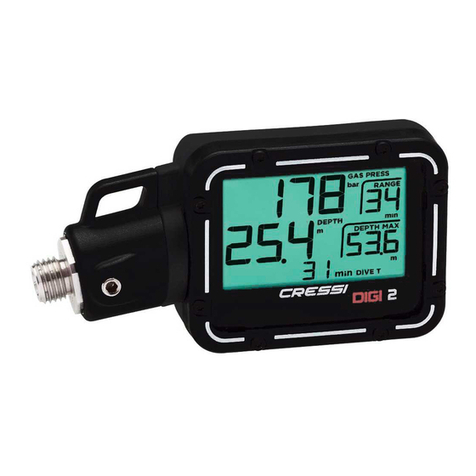
Cressi
Cressi DIGI 2 User manual
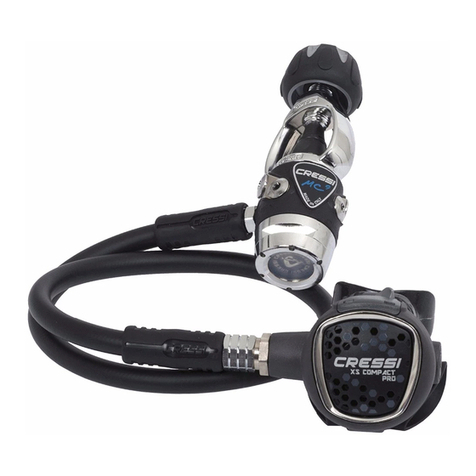
Cressi
Cressi MC9 S.C. Manual
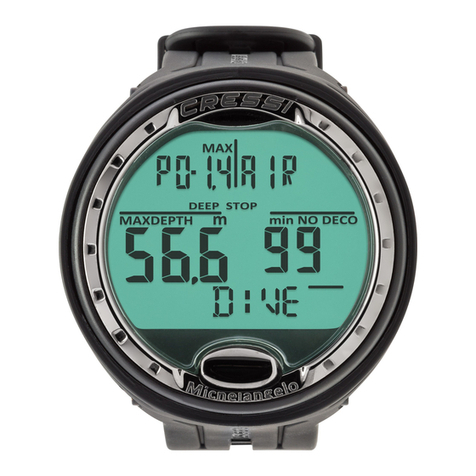
Cressi
Cressi Michelangelo User manual

Cressi
Cressi AQUAWING Manual

Cressi
Cressi DIGI 2 User manual

Cressi
Cressi MC9 S.C. Manual
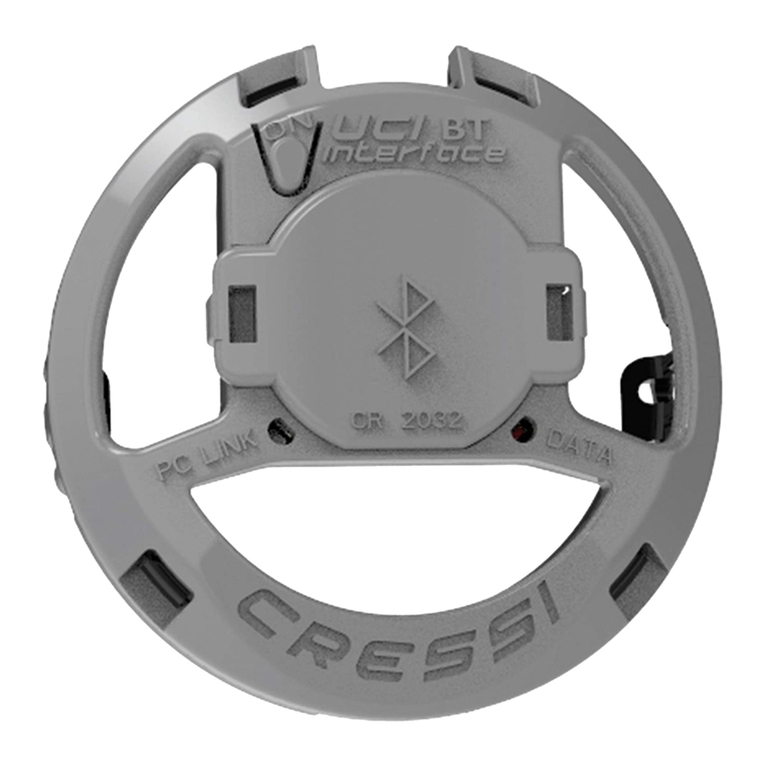
Cressi
Cressi Bluetooth Interface User manual
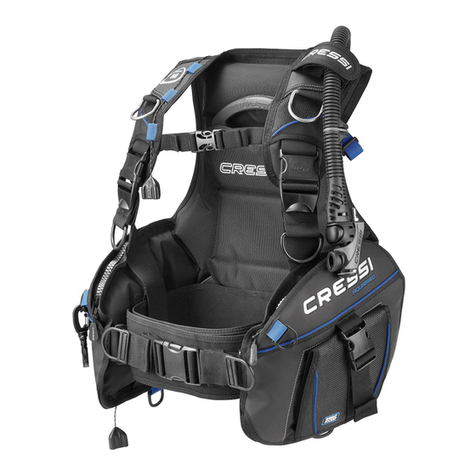
Cressi
Cressi Aquapro Manual

Cressi
Cressi DRAKE User manual
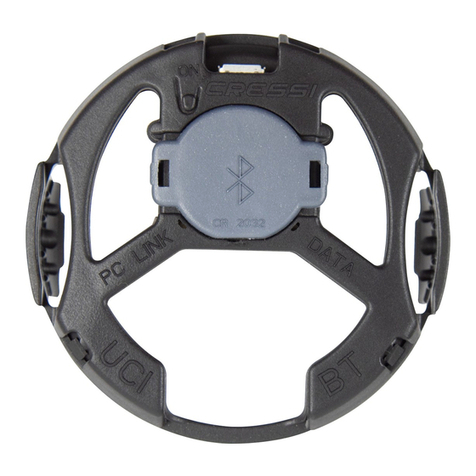
Cressi
Cressi BT Interface User manual

Cressi
Cressi CARTESIO User manual

Cressi
Cressi EDY User manual
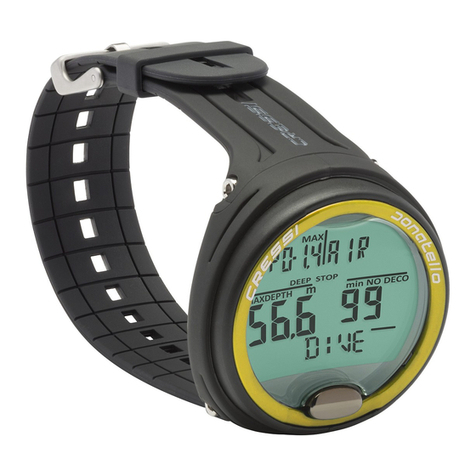
Cressi
Cressi DONATELLO User manual
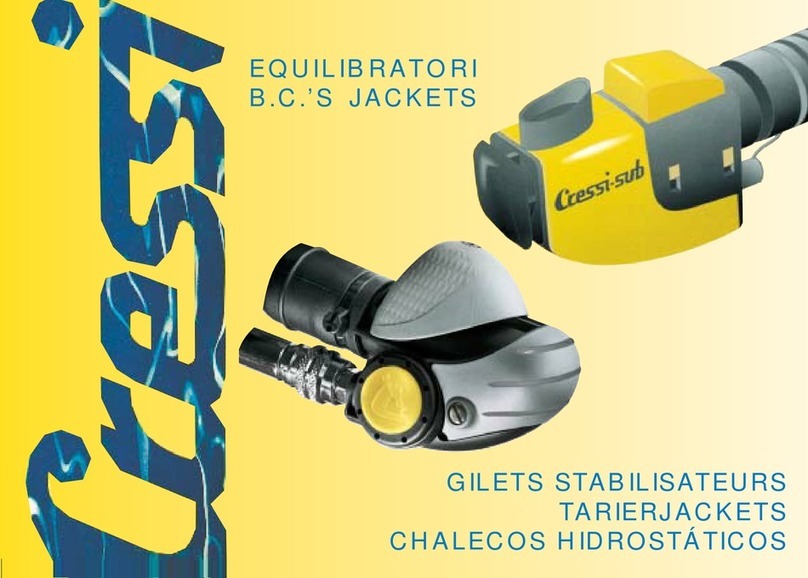
Cressi
Cressi SUB series User manual
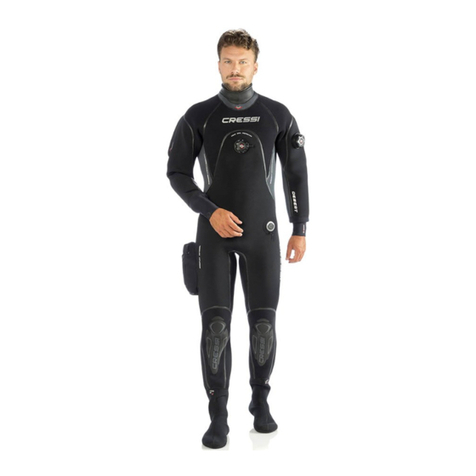
Cressi
Cressi DESERT Manual

Cressi
Cressi Leonardo Manual

